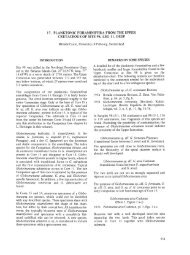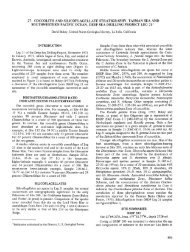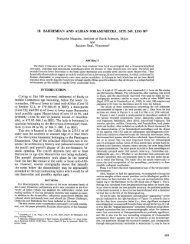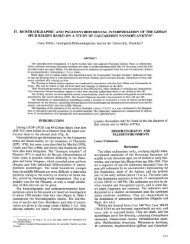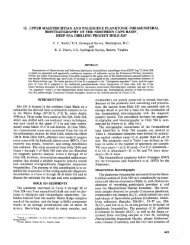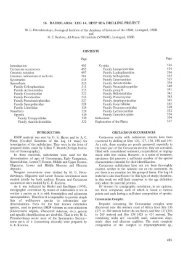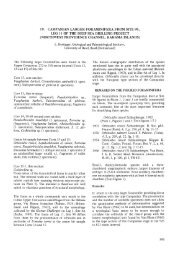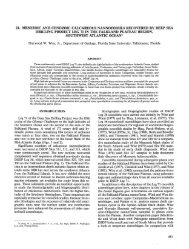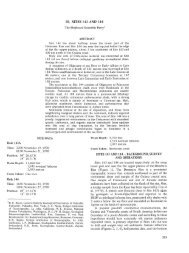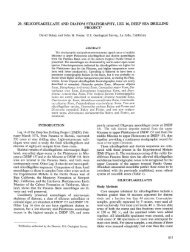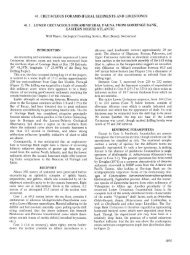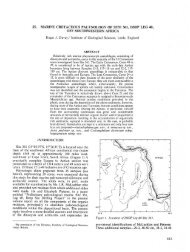18. Eocene Diatoms and Siliceous Sponge Spicules from
18. Eocene Diatoms and Siliceous Sponge Spicules from
18. Eocene Diatoms and Siliceous Sponge Spicules from
You also want an ePaper? Increase the reach of your titles
YUMPU automatically turns print PDFs into web optimized ePapers that Google loves.
<strong>18.</strong> EOCENE DIATOMS AND SILICEOUS SPONGE SPICULES FROM THE NORTHWESTERN<br />
ATLANTIC OCEAN, DSDP SITES 417 AND 418<br />
David Bukry, U.S. Geological Survey, Scripps Institution of Oceanography, La Jolla, California<br />
Deep Sea Drilling Project Legs 51 to 53, drilled in the<br />
Nares Abyssal Plain south of Bermuda, concentrated on<br />
recovery of old oceanic crust. During drilling, a short<br />
interval of <strong>Eocene</strong> pelagic clay was recovered that is rich in<br />
radiolarian debris with intercalated layers of radiolarian<br />
ooze. Associated fossils were reported aboard ship to be<br />
sponge spicules <strong>and</strong> silicoflagellates. Shore-laboratory<br />
study of these sediments has shown that the radiolarians are<br />
fragmented <strong>and</strong> etched, especially in zeolite-rich samples.<br />
<strong>Sponge</strong> spicules are of low diversity <strong>and</strong> moderate to poor<br />
preservation. Silicoflagellates are missing; diatoms occur<br />
sparsely within the interval. The diatoms are fragmented<br />
<strong>and</strong> belong to only a few solution-resistant taxa such as<br />
Arachnoidiscus, Liostephania, Melosira (s. ampl.), <strong>and</strong><br />
Pyrgupyxis. On experimental evidence (Mikkelsen, 1977),<br />
the poorly preserved state of the abundant radiolarians <strong>and</strong><br />
sparse diatoms should preclude the presence of<br />
silicoflagellates; that is supported by these observations. A<br />
few specimens of fragmented Arachnoidiscus <strong>and</strong> more<br />
common Melosira, typical shallow-water genera, suggest<br />
downslope transport of some of the biogenic components to<br />
this deep site, probably <strong>from</strong> the North American shelf or<br />
Blake Plateau, where more abundant <strong>Eocene</strong> diatomites <strong>and</strong><br />
spiculites are known (Beall <strong>and</strong> Fischer, 1969; Bukry,<br />
1978).<br />
Of 49 samples examined <strong>from</strong> Site 417 <strong>and</strong> adjacent Site<br />
418, only nine contain sparse to common diatoms <strong>and</strong><br />
siliceous sponge spicules (Figure 1). Representative forms<br />
presented in Plate 1 illustrate the preservation state of<br />
specimens. A single solution-thinned specimen of the<br />
ebridian Ebriopsis sp. cf. E. antiqua was observed in<br />
Sample 417A-14-2, 15-17 cm (124 m).<br />
ACKNOWLEDGMENT<br />
I thank John Barron, U.S. Geological Survey, <strong>and</strong> Naja<br />
Mikkelsen, Danmarks Geologiske Unders0gelse, for their reviews<br />
of this report.<br />
REFERENCES<br />
Beall, A. O., Jr., <strong>and</strong> Fischer, A. G., 1969. Sedimentology. In<br />
Ewing, M., Worzel, J. L., et ah, Initial Reports of the Deep<br />
Sea Drilling Project,v. 1: Washington (U.S. Government<br />
Printing Office), p. 521-593.<br />
Bukry, D., 1978. Cenozoic Coccolith, silicoflagellate, <strong>and</strong> diatom<br />
stratigraphy, Deep Sea Drilling Project, Leg 44. In Benson,<br />
W.E., Sheridan, R.E., et al., Initial Reports of the Deep Sea<br />
Drilling Project, v. 44: Washington (U.S. Government<br />
Printing Office), p. 807-864.<br />
Fenner, J., 1978. Cenozoic diatom biostratigraphy of the<br />
equatorial <strong>and</strong> southern Atlantic Ocean. In Perch-Nielsen, K.,<br />
Supko, P. R., et al., Initial Reports of the Deep Sea Drilling<br />
Project Supplement to Volumes 38, 39, 40 <strong>and</strong> 41: Washington<br />
(U.S. Government Printing Office), p. 491-624.<br />
Glezer, Z. I., Jousé, A. P., Markova, I. V., Proshkina-Lavrenko,<br />
A. I., <strong>and</strong> Sheshukova-Poretzkaya, V. S., 1974. The diatoms<br />
of the USSR, fossil <strong>and</strong> recent: Leningrad (Publishing House<br />
NAUKA), v. 1, p. 1-400.<br />
Gombos, A. M., Jr., 1977. Paleogene <strong>and</strong> Neogene diatoms <strong>from</strong><br />
the Falkl<strong>and</strong> Plateau <strong>and</strong> Malvinas outer basin: Leg 36, Deep<br />
Sea Drilling Project. In Barker, P. F., Dalziel, I.W.D., et al.,<br />
Initial Reports of the Deep Sea Drilling Project, v. 36:<br />
Washington (U.S. Government Printing Office), p. 575-687.<br />
Mikkelsen, N., 1977. On the origin of Ethmodiscus ooze, Marine<br />
Micropaleontology, v. 2, p. 35-46.<br />
Schrader, H. J. <strong>and</strong> Fenner, J., 1976. Norwegian Sea Cenozoic<br />
diatom biostratigraphy <strong>and</strong> taxonomy. In Talwani, M.,<br />
Udintsev, G., et al., Initial Reports of the Deep Sea Drilling<br />
Project, v. 38: Washington (U.S. Government Printing<br />
Office), p. 921-1099.<br />
851
D. BUKRY<br />
Sample<br />
(Interval in cm)<br />
417A-14-2, 15-17<br />
417 A-14-4, 39-40<br />
417A-15-2, 33-34<br />
417A-15-4, 20-21<br />
417A-15-4, 80-81<br />
417A-16-2, 55-57<br />
417A-16-4, 93-95<br />
417A-16-6, 126-128<br />
418A-6-1, 90-92<br />
pth (m)<br />
cu<br />
Q<br />
124<br />
127<br />
133<br />
136<br />
136<br />
143<br />
147<br />
150<br />
159<br />
itoms<br />
b<br />
R<br />
R<br />
—<br />
F<br />
R<br />
R<br />
R<br />
R<br />
-<br />
Microfossil<br />
Abundance<br />
<br />
icoflagellat)<br />
Sil<br />
-<br />
-<br />
-<br />
_<br />
_<br />
_<br />
-<br />
-<br />
-<br />
ridians<br />
_α<br />
UI<br />
R<br />
—<br />
-<br />
_<br />
-<br />
_<br />
_<br />
-<br />
-<br />
D. BUKRY<br />
854<br />
PLATE 1<br />
<strong>Diatoms</strong> (Figures 1 to 10), siliceous sponge spicules (Figures 11 to<br />
17, <strong>and</strong> 21), <strong>and</strong> noncalcareous microfossils of uncertain origin (Figures<br />
18 to 20) <strong>from</strong> the <strong>Eocene</strong> of DSDP Hole 417A. Figures 1-7, 9, 10, 12,<br />
15, <strong>and</strong> 21 are magnified 800×; scale bar equals 10 µm. Figures 8,11,<br />
13, 14, <strong>and</strong> 16-20 are magnified 35O×; scale bar equals 20 µm.<br />
Figure<br />
Figuresi<br />
2-4<br />
Figure 5<br />
Figure 6<br />
Figure 7<br />
Figure 8<br />
Figure 9<br />
Figure<br />
1<br />
10<br />
Arachnoidiscus sp. Sample 417A-15-4, 20-21 cm<br />
(136 m sub-bottom).<br />
Liostephania spp. Sample 417A-16-4, 93-95 cm<br />
(147 m).<br />
Melosira sp. cf. M. sulcata coronata Grunow.<br />
Sample 417A-16-4, 93-95 cm (147 m).<br />
Melosira concentrica Schulz. Sample 417A-15-4,<br />
20-21 cm (136 m).<br />
Melosira sp. or Pseudopodosira sp. Sample<br />
417A-15-4, 20-21 cm (136 m).<br />
Pyrgupyxis sp. Sample 417A-16-2, 55-57 cm<br />
(143 m).<br />
Trinacria sp. Sample 417A-16-2, 55-57 cm (143 m).<br />
Xanthiopyxis oblonga Ehrenberg. Sample 417A-15-4,<br />
20-21 cm (136 m).<br />
Figure 11 Acanthaster (recticiliate). Sample 417A-16-4, 93-95<br />
cm (147 m).<br />
Figure 12 Diancistron. Sample 417A-16-4, 93-95 cm (147 m).<br />
Figures 13, 14 Oxeas (curved).<br />
13. Megasclere, Sample 417A-16-4, 93-95 cm<br />
(147 m).<br />
14. Microsclere, Sample 417A-16-4, 93-95 cm<br />
(147 m).<br />
Figure 15 Oxea? (atypical sinuous canal). Sample 417A-15-4,<br />
20-21 cm (136 m).<br />
Figure 16 Strongyle. Sample 417A-16-4, 93-95 cm (147 m).<br />
Figure 17 Tylostyle. Sample 417A-16-4, 93-95 cm (147 m).<br />
Figures 18, 19 Microfossil A. Sample 417A-16-4, 93-95 cm<br />
(147 m).<br />
Figure 20 Microfossil B. Sample 417A-16-4, 93-95 cm<br />
(147 m).<br />
Figure 21 Spheraster. Sample 417A-16-4, 93-95 cm (147 m).
PLATE 1<br />
EOCENE DIATOMS AND SILICEOUS SPONGE SPICULES<br />
855



